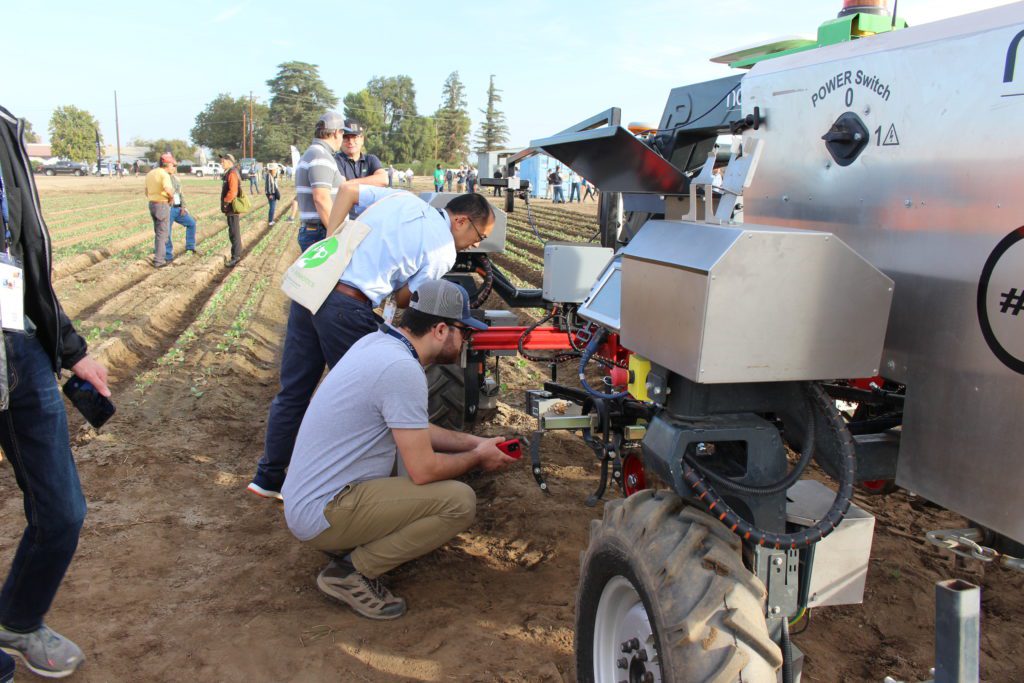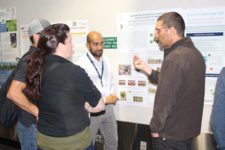

Nov 17, 2022Field of Machines: Automation eases some tasks, but focus is on harvest
FRESNO, Calif. – As Congress prepares yet again to consider agriculture labor reform through the Farm Workforce Modernization Act, dozens of autonomous sprayers, weeders and cultivators are entering fields, orchards and vineyards every day in California.
The state is a testing ground for new technology, increasingly more sophisticated as companies seek to crack the Holy Grail of specialty crop tech success: an efficient harvesting machine that can tell when a vegetable is ready, and then cut, pick or dig it up.


Hundreds of growers, academics and Extension agents, tech startup representatives and others discussed the current state and future of robotics and autonomous machinery in agriculture at the inaugural FIRA-USA conference on ag robotics and automation. The Oct. 18-20 event featured a day of education sessions, a day of manufacturers promoting their equipment and a day of demonstrations in fields and a vineyard.
The opening panel session on the needs and challenges of developing automation in agriculture underscored how the lack of labor is pushing manufacturers and growers into partnerships as technology is tested in real-world conditions.
One robot, one crop concept disliked
Walt Duflock, vice president of agtech innovation for Western Growers, said three issues have overshadowed growers’ concerns for decades: food safety, water and labor. The U.S. has lost 70% of its farmworkers over the past few decades, he said, and the number of participants in the H-2A temporary visa program grew six-fold in the past 16 years, to about 300,000 last year. While the program secures workers, it also sets wages and mandates growers supply workers housing and transportation.
In early 2021, Western Growers launched the Global Harvest Automation Initiative to take a comprehensive look at how harvest innovation is affecting their operations across fresh products for specialty crops and an in-depth view of the innovators who are doing the heavy lifting by crop type. The results are available for download at agharvestreport.com.
“What we found out was that it’s a very early space in automation,” Duflock said on the panel. “Seventy-five percent of the startups we talked to have not raised real capital. No venture capital yet. And the other 25% have only done an A round or B round. Those aren’t the scale rounds, those are a couple robots in a couple fields, not robots wherever we need them.”
Investors like to see multi-purpose solutions, Duflock said, which limits some automation in the specialty crop sector, which has diverse needs and technical know-how during harvest.
“What I see is, things like weeding and thinning, where you can do more than one crop with one robot, are starting to pull away, get more capital, starting to scale,” Duflock said. “You’ll see the names here this week, Carbon Robotics, FarmWise, Verdant, Stout are all here.
“One robot per crop is very unattractive for venture capital, so we need to get more capital-efficient for those startups and we need more effective grower and startup interaction so we can get this stuff to market faster,” Duflock said.
Ed Barnes, senior director of agricultural and environmental research for Cotton Inc., described the process formerly used to harvest cotton: someone would drive a boll buggy, similar to a grain cart, the harvester itself, and module builder on the edge of the field to compress the bales. In all, the process needed five people.
Then about 10 years ago, John Deere brought a cotton harvester to the market that needed only one person to operate it.
“The price tag on that is not small. It’s a million-dollar machine, and requires about 2,000 acres of cotton (to harvest to justify the expense),” Barnes told the audience. “I’d really like to have a harvester that didn’t require someone to have that much cotton. We’re starting to call someone with 800 acres a small farmer.”
Just a decade later, however, the John Deere harvester is the predominant cotton harvester in fields. “When you bring a technology that will reduce a farmer’s labor, they will invest in it,” he said. Barnes said a concern in the grower community is herbicide resistance.
“Many of you are aware that we are continuing to see an increasing number of weed species that have resistance to more than one herbicide, and we’re not seeing any new modes of action since the 1980s,” he said. “We are coming near the end of our ability to control weeds with herbicides.”
The use of those herbicides allowed producers to move away from tillage practices, reducing labor, soil erosion and other issues.
“We look at automation and robotics as one of the key tools to helping us combat escape weeds, and that’s a very near-term thing that we need,” Barnes said.
Go or no go, labor must be ready
All tasks on the farm are not equal, said Mojtaba Ahmadi, senior production automation engineer for the Cal Poly Strawberry Center. Growers and tech companies are working to accommodate needs for automation during high and low demand.
“There are certain times you need more labor to do certain tasks, like harvesting, but there are times they don’t,” Ahmadi said. “… Sometimes, it’s a zero or 100% situation. You either have the labor you need to do what you need to do, or it’s a no-go.”
Strawberry growers, however, are very eager to learn about automated harvesting.
“If you ask them about what sort of performance they are looking for, they will really be flexible at the beginning, because they want to step in and try it,” Ahmadi said. “But they’re expecting you to understand their needs and get to the point where that’s really helping them.”
While strawberry harvesting is a specific area of research, growers are also interested in less time-sensitive tasks, from pruning to runner cutting, he said.
“You can do that at any time, and you don’t have to finish it like within a week, you can just keep doing it in the background, and that would save a ton of labor for growers,” Ahmadi said.
Robotics vs. automation
Michael Roots, a specialist in field outreach and education for the Almond Board of California, said automation has been a part of almond harvest, which has increased efficiency.


“We’ve all talked here about labor being the key driver of automation and robotics, and I think not only labor, but the quality of that labor,” Roots said. “As almonds have moved into mechanization, a lot of those processes require skilled labor.”
As scarcity of water is leading to advances in irrigation technology, rising input costs is increasing interest in precision sprayers.
Roots said he’s seen a lot of interest in sprayer equipment, whether fully robotic/autonomous or equipment pulled behind a tractor that can sense areas that need less or more treatment, which saves in labor costs and wasting costly chemicals.
Another area of interest, he said, is off-ground harvest, catching the nuts before they hit the ground when the tree shaker sets them free.
“It was really interesting to hear Ed (Barnes) talk about how they’ve truly changed their harvesting process,” Roots said. “Obviously, almonds have become very mechanized from where we started, but we’re really seeing changes driven by labor, driven by food safety and other issues.”
Ines Hanrahan, executive director of the Washington Tree Fruit Research Commission, said the biggest advance in harvesting tree fruit in the past two decades is bringing movable platforms into orchards during harvest to replace ladders, a major cause of injuries.
While the current focus remains on harvest, the two other labor-intensive jobs in the tree fruit industry are thinning and pruning.
“A lot of our efforts have to go into those areas and we’re really excited to be here, to tell people we’re ready, we’re ready to host you,” she said. “We have changed our orchards and we’re ready to bring you on and help you get your company going if you can help us with those three main tasks. “
Hanrahan said it typically falls on the bigger operations to be early adopters, which allows smaller growers to benefit from trial-and-error down the line. Different business models, such as lease vs. purchase, can also motivate smaller farming operations to become involved, she said.
— Chris Koger, managing editor
Top photo: During field day demonstrations at FIRA-USA, participants examined equipment like Naio’s Orio, with weeding implements from K.U.L.T., a German manufacturer. Photos: Chris Koger
Second photo: In the aftermath of Carbon Robotics’ Laserweeder field pass, FIRA-USA attendees spot the charred remains of weeds.
Bottom photo: Outside meeting rooms at the Fresno Convention Center, attendees at FIRA-USA had the opportunity to learn about student research between sessions.














